Nationwide Assessment of Water Quality in Rivers across Lebanon by Quantifying Fecal Indicators Densities and Profiling Antibiotic Resistance of Escherichia coli
Abstract
:1. Introduction
2. Materials and Methods
2.1. Collection of Water Samples from Rivers across Lebanon
2.2. Quantification of Fecal Coliforms and E. coli Densities
2.3. Assessment of the Antibiotic Resistance Phenotypes of the E. coli Isolates
3. Results
3.1. Densities of Fecal Coliforms and E. coli in River Water Samples
3.2. Comparison of Fecal Coliforms and E. coli Counts to Irrigation and Recreation Standards
3.3. The Antibiotic Resistance Profiles of E. coli Isolated from Water
4. Discussion
5. Conclusions
Author Contributions
Funding
Institutional Review Board Statement
Informed Consent Statement
Data Availability Statement
Acknowledgments
Conflicts of Interest
References
- Cosgrove, W.J.; Loucks, D. Water management: Current and future challenges and research directions. Water Resour. Res. 2015, 51, 4823–4839. [Google Scholar] [CrossRef] [Green Version]
- Onyango, A.E.; Okoth, M.W.; Kunyanga, C.N.; Aliwa, B.O. Microbiological quality and contamination level of water sources in Isiolo County in Kenya. J. Environ. Public Health 2018, 2018. [Google Scholar] [CrossRef] [Green Version]
- Boretti, A.; Rosa, L. Reassessing the Projections of the World Water Development Report. NPJ Clean Water 2019, 2, 1–6. [Google Scholar] [CrossRef]
- Mishra, B.P. Water pollution and food contamination in relation to health hazards: Food safety as a global challenge. Pollutry 2008, 27, 395–400. [Google Scholar]
- Dubois, O. The State of the World’s Land and Water Resources for Food and Agriculture: Managing Systems at Risk; Dubois, O., Ed.; Earthscan: London, UK, 2011; p. xxii+285. [Google Scholar]
- Decol, L.T.; Casarin, L.S.; Hessel, C.T.; Batista, A.C.F.; Allende, A.; Tondo, E.C. Microbial quality of irrigation water used in leafy green production in Southern Brazil and its relationship with produce safety. J. Food Microbiol. 2017, 65, 105–113. [Google Scholar] [CrossRef] [PubMed]
- Uyttendaele, M.; Jaykus, L.A.; Amoah, P.; Chiodini, A.; Cunliffe, D.; Jacxsens, L.; Holvoet, K.; Korsten, L.; Lau, M.; McClure, P. Microbial hazards in irrigation water: Standards, norms, and testing to manage use of water in fresh produce primary production. Compr. Rev. Food Sci. Food Saf. 2015, 14, 336–356. [Google Scholar] [CrossRef]
- Marino, D.D. Water and food safety in the developing world: Global implications for health and nutrition of infants and young children. J. Acad. Nutr. Diet. 2007, 107, 1930–1934. [Google Scholar] [CrossRef]
- Hlavsa, M.C.; Aluko, S.K.; Miller, A.D.; Person, J.; Gerdes, M.E.; Lee, S.; Laco, J.P.; Hannapel, E.J.; Hill, V.R. Outbreaks Associated with Treated Recreational Water—United States, 2015–2019. MMWR 2021, 70, 733. [Google Scholar] [CrossRef]
- Esschert, K.L.V.; Mattioli, M.C.; Hilborn, E.D.; Roberts, V.A.; Yu, A.T.; Lamba, K.; Arzaga, G.; Zahn, M.; Marsh, Z.; Combes, S. Outbreaks Associated with Untreated Recreational Water—California, Maine, and Minnesota, 2018–2019. MMWR 2020, 69, 781. [Google Scholar] [CrossRef]
- Gelting, R.; Baloch, M. A systems analysis of irrigation water quality in environmental assessments related to foodborne outbreaks. Aquat. Procedia 2013, 1, 130–137. [Google Scholar] [CrossRef] [PubMed]
- Kraemer, S.A.; Ramachandran, A.; Perron, G. Antibiotic pollution in the environment: From microbial ecology to public policy. Microorganisms 2019, 7, 180. [Google Scholar] [CrossRef] [PubMed] [Green Version]
- Sanderson, C.E.; Fox, J.T.; Dougherty, E.R.; Cameron, A.D.; Alexander, K.A. The changing face of water: A dynamic reflection of antibiotic resistance across landscapes. Front. Microbiol. 2018, 9, 1894. [Google Scholar] [CrossRef] [PubMed]
- Tiedje, J.M.; Fang, W.; Manaia, C.M.; Virta, M.; Sheng, H.; Liping, M.; Zhang, T.; Edward, T. Antibiotic resistance genes in the human-impacted environment: A One Health perspective. Pedosphere 2019, 29, 273–282. [Google Scholar] [CrossRef]
- Danner, M.C.; Robertson, A.; Behrends, V.; Reiss, J. Antibiotic pollution in surface fresh waters: Occurrence and effects. Sci. Total Environ. 2019, 664, 793–804. [Google Scholar] [CrossRef]
- Nappier, S.P.; Liguori, K.; Ichida, A.M.; Stewart, J.R.; Jones, K.R. Antibiotic resistance in recreational waters: State of the science. Int. J. Environ. Res. Public Health 2020, 17, 8034. [Google Scholar] [CrossRef]
- Mateo-Sagasta, J.; Zadeh, S.M.; Turral, H.; Burke, J. Water Pollution from Agriculture: A Global Review. Executive Summary. 2017. Available online: http://www.fao.org/3/i7754e/i7754e.pdf (accessed on 10 June 2021).
- Manyi-Loh, C.; Mamphweli, S.; Meyer, E.; Okoh, A. Antibiotic use in agriculture and its consequential resistance in environmental sources: Potential public health implications. Molecules 2018, 23, 795. [Google Scholar] [CrossRef] [Green Version]
- Daou, C.; Salloum, M.; Legube, B.; Kassouf, A.; Ouaini, N. Characterization of spatial and temporal patterns in surface water quality: A case study of four major Lebanese rivers. Environ. Monit. Assess. 2018, 190, 1–16. [Google Scholar] [CrossRef]
- Fouz, N.; Pangesti, K.N.; Yasir, M.; Al-Malki, A.L.; Azhar, E.I.; Hill-Cawthorne, G.A.; Ghany, M.A.E. The contribution of wastewater to the transmission of antimicrobial resistance in the environment: Implications of mass gathering settings. Infect. Dis. Trop. Med. 2020, 5, 33. [Google Scholar] [CrossRef] [Green Version]
- Yu, Y.; Zhu, X.; Wu, G.; Wang, C.; Yuan, X. Analysis of antibiotic resistance of Escherichia coli isolated from the Yitong River in North-east China. Front. Environ. Sci. Eng. 2019, 13, 1–9. [Google Scholar] [CrossRef]
- Kumar, K.; Gupta, S.C.; Chander, Y.; Singh, A.K. Antibiotic use in agriculture and its impact on the terrestrial environment. Adv. Agron. 2005, 87, 1–54. [Google Scholar] [CrossRef]
- Baquero, F.; Martínez, J.-L.; Cantón, R. Antibiotics and antibiotic resistance in water environments. Curr. Opin. Biotechnol. 2008, 19, 260–265. [Google Scholar] [CrossRef]
- Batterman, S.; Eisenberg, J.; Hardin, R.; Kruk, M.E.; Lemos, M.C.; Michalak, A.M.; Mukherjee, B.; Renne, E.; Stein, H.; Watkins, C.; et al. Sustainable control of water-related infectious diseases: A review and proposal for interdisciplinary health-based systems research. Environ. Health Perspect. 2009, 117, 1023–1032. [Google Scholar] [CrossRef] [PubMed] [Green Version]
- Pruss-Ustun, A.; Bos, R.; Gore, F.; Bartram, J. Safer Water, Better Health: Costs, Benefits and Sustainability of Interventions to Protect and Promote Health. World Health Organization (WHO). Available online: http://apps.who.int/iris/bitstream/handle/10665/43840/9789241596435_eng.pdf?sequence=1 (accessed on 10 June 2021).
- Damania, R.; Desbureaux, S.; Rodella, A.-S.; Russ, J. Quality Unknown: The Invisible Water Crisis; World Bank Publications: Washington, DC, USA, 2019. [Google Scholar]
- Mcheik, A.; Awad, A.; Fadel, A.; Mounzer, C.; Nasreddine, S. Effect of irrigation water quality on the microbial contamination of fresh vegetables in the bekaa valley, Lebanon. AJAF 2018, 6, 191–197. [Google Scholar]
- Lebanon Crisis 2017–2020 Response Plan. Available online: https://www.ilo.org/wcmsp5/groups/public/---arabstates/---ro-beirut/documents/publication/wcms_542062.pdf (accessed on 10 June 2021).
- Kassem, I.I.; Jaafar, H.J. The potential impact of water quality on the spread and control of COVID-19 in Syrian refugee camps in Lebanon. Water Int. 2020, 45, 423–429. [Google Scholar] [CrossRef]
- Sulaiman, A.A.A.; Kassem, I.I. First report on the detection of the plasmid-borne colistin resistance gene mcr-1 in multi-drug resistant E. coli isolated from domestic and sewer waters in Syrian refugee camps in Lebanon. Travel Med. Infect. Dis. 2019, 30, 117–120. [Google Scholar] [CrossRef] [PubMed]
- Jaafar, H.; King-Okumu, C.; Haj-Hassan, M.; Abdallah, C.; El-Korek, N.; Ahmad, F. Water Resources within the Upper Orontes and Litani Basins: A Balance, Demand and Supply Analysis amid the Syrian Refugees Crisis; International Institute for Environment and Development: London, UK, 2016. [Google Scholar]
- Jaafar, H.; Ahmad, F.; Holtmeier, L.; King-Okumu, C. Refugees, water balance, and water stress: Lessons learned from Lebanon. Ambio 2020, 49, 1179–1193. [Google Scholar] [CrossRef] [PubMed] [Green Version]
- Karnib, A. Assessing population coverage of safely managed wastewater systems: A case study of Lebanon. J. Water Sanit. Hyg. Dev. 2016, 6, 313–319. [Google Scholar] [CrossRef]
- Karam, F.; Mouneimne, A.H.; El-Ali, F.; Mordovanaki, G.; Rouphael, Y. Wastewater Management and Reuse in Lebanon. Res. J. Appl. Sci. 2013, 9, 2868–2879. [Google Scholar]
- Geara-Matta, D.; Moilleron, R.; El Samarani, A.; Lorgeoux, C.; Chebbo, G. State of Art about water uses and wastewater management in Lebanon. In Proceedings of the World Wide Workshop for Young Environmental Scientists, Arcueil, France, 31 May–4 June 2010. [Google Scholar]
- Hmede, Z.; Kassem, I.I. The colistin resistance gene mcr-1 is prevalent in commensal Escherichia coli isolated from preharvest poultry in Lebanon. Antimicrob. Agents Chemother. 2018, 62, e01304–e01318. [Google Scholar] [CrossRef] [Green Version]
- Hmede, Z.; Jaafar, H.; Kassem, I.I. Emergence of plasmid-borne colistin resistance gene mcr-1 in multidrug-resistant Escherichia coli isolated from irrigation water in Lebanon. Int. J. Antimicrob. Agents 2019, 54, 102–104. [Google Scholar] [CrossRef]
- Hassan, J.; Eddine, R.Z.; Mann, D.; Li, S.; Deng, X.; Saoud, I.P.; Kassem, I.I. The mobile colistin resistance gene, mcr-1.1, is carried on IncX4 plasmids in multidrug resistant E. coli isolated from Rainbow Trout aquaculture. Microorganisms 2020, 8, 1636. [Google Scholar] [CrossRef]
- Sulaiman, A.A.A.; Kassem, I.I. First report of the plasmid-borne colistin resistance gene (mcr-1) in Proteus mirabilis isolated from domestic and sewer waters in Syrian refugee camps. Travel Med. Infect. Dis. 2020, 33, 101482. [Google Scholar] [CrossRef]
- Sourenian, T.; Mann, D.; Li, S.; Deng, X.; Jaafar, H.; Kassem, I.I. Dissemination of multidrug-resistant Escherichia coli harboring the mobile colistin resistance gene mcr-1.1 on transmissible plasmids in the Mediterranean Sea. J. Glob. Antimicrob. Resist. 2020, 22, 84–86. [Google Scholar] [CrossRef] [PubMed]
- Hassan, J.; Mann, D.; Li, S.; Deng, X.; Kassem, I.I. Emergence of the mobile colistin resistance gene mcr-1 in multidrug-resistant Escherichia coli isolated from the fecal matter of toddlers in a community. Antimicrob. Agents Chemother. 2021, 65, e00243-21. [Google Scholar] [CrossRef]
- Kassem, I.I.; Hijazi, M.A.; Saab, R. On a collision course: The availability and use of colistin-containing drugs in human therapeutics and food-animal farming in Lebanon. J. Glob. Antimicrob. Resist. 2019, 16, 162–164. [Google Scholar] [CrossRef] [PubMed]
- Al-Mir, H.; Osman, M.; Azar, N.; Madec, J.-Y.; Hamze, M.; Haenni, M. Emergence of clinical mcr-1-positive Escherichia coli in Lebanon. J. Glob. Antimicrob. Resist. 2019, 19, 83–84. [Google Scholar] [CrossRef] [PubMed]
- Salloum, T.; Panossian, B.; Bitar, I.; Hrabak, J.; Araj, G.F.; Tokajian, S. First report of plasmid-mediated colistin resistance mcr-8.1 gene from a clinical Klebsiella pneumoniae isolate from Lebanon. Antimicrob. Resist. Infect. Control 2020, 9, 1–7. [Google Scholar] [CrossRef]
- Osman, M.; Al Mir, H.; Rafei, R.; Dabboussi, F.; Madec, J.-Y.; Haenni, M.; Hamze, M. Epidemiology of antimicrobial resistance in Lebanese extra-hospital settings: An overview. J. Glob. Antimicrob. Resist. 2019, 17, 123–129. [Google Scholar] [CrossRef]
- Dandachi, I.; Sokhn, E.S.; Dahdouh, E.A.; Azar, E.; El-Bazzal, B.; Rolain, J.-M.; Daoud, Z. Prevalence and characterization of multi-drug-resistant gram-negative bacilli isolated from Lebanese poultry: A nationwide study. Front. Microbiol. 2018, 9, 550. [Google Scholar] [CrossRef] [Green Version]
- Dandachi, I.; Fayad, E.; Sleiman, A.; Daoud, Z.; Rolain, J.-M. Dissemination of multidrug-resistant and mcr-1 gram-negative bacilli in broilers, farm workers, and the surrounding environment in Lebanon. Microb. Drug Resist. 2020, 26, 368–377. [Google Scholar] [CrossRef] [PubMed]
- Dandachi, I.; Fayad, E.; El-Bazzal, B.; Daoud, Z.; Rolain, J.-M. Prevalence of extended-Spectrum Beta-lactamase-producing gram-negative bacilli and emergence of mcr-1 colistin resistance gene in Lebanese swine farms. Microb. Drug Resist. 2018, 25, 233–240. [Google Scholar] [CrossRef]
- Haydar, C.; Nehme, N.; Awad, S.; Koubayssi, B.; Fakih, M.; Yaacoub, A.; Toufaily, J.; Villieras, F.; Hamieh, T. Physiochemical and microbial assessment of water quality in the Upper Litani River Basin, Lebanon. Environ. Earth Sci. 2014, 4, 87–97. [Google Scholar]
- Food and Agriculture Organization (FAO). AQUASTAT Country Profile–Lebanon. Available online: http://www.fao.org/3/ca0344en/CA0344EN.pdf (accessed on 10 June 2021).
- U.S. Environmental Protection Agency (EPA). Water Quality Standards Handbook: Chapter 3: Water Quality Criteria. EPA-823-B-17-001. EPA Office of Water, Office of Science and Technology, Washington, DC. 2017. Available online: https://www.epa.gov/sites/production/files/2014-10/documents/handbook-chapter3.pdf (accessed on 10 June 2021).
- Holcomb, D.A.; Stewart, J. Microbial indicators of fecal pollution: Recent progress and challenges in assessing water quality. Curr. Environ. Health Rep. 2020, 7, 1–14. [Google Scholar] [CrossRef] [PubMed]
- Cabral, J.P. Water microbiology. Bacterial pathogens and water. Int. J. Environ. Res. Public Health 2010, 7, 3657–3703. [Google Scholar] [CrossRef] [PubMed]
- European Food Safety Authority (EFSA). Report from the Task Force on Zoonoses data collection including guidance for harmonized monitoring and reporting of antimicrobial resistance in commensal Escherichia coli and Enterococcus spp. from food animals. EFSA J. 2008, 6, 1831–4732. [Google Scholar]
- Colque Navarro, P.; Fernandez, H.; Möllby, R.; Otth, L.; Tiodolf, M.; Wilson, M.; Kühn, I. Antibiotic resistance in environmental Escherichia coli–a simple screening method for simultaneous typing and resistance determination. J. Water Health 2014, 12, 692–701. [Google Scholar] [CrossRef]
- Bailey, J.K.; Pinyon, J.L.; Anantham, S.; Hall, R.M. Commensal Escherichia coli of healthy humans: A reservoir for antibiotic-resistance determinants. J. Med. Microbiol. 2010, 59, 1331–1339. [Google Scholar] [CrossRef]
- U.S. Environmental Protection Agency (US-EPA). Sampling and Consideration of Variability (Temporal and Spatial) for Monitoring of Recreational Waters. Available online: https://www.epa.gov/sites/default/files/2015-11/documents/sampling-consideration-recreational-waters.pdf (accessed on 10 June 2021).
- Kassem, I.I.; Nasser, N.A.; Salibi, J. Prevalence and loads of fecal pollution indicators and the antibiotic resistance phenotypes of Escherichia coli in raw minced beef in Lebanon. Foods 2020, 9, 1543. [Google Scholar] [CrossRef] [PubMed]
- Système D’évaluation De La Qualité De L’eau Des Cours D’eau (SEQ-EAU). Version 2. Available online: https://bretagne-environnement.fr/systeme-evaluation-qualite-eau-cours-eau-seq-eau (accessed on 10 June 2021).
- Clinical and Laboratory Standards Institute (CLSI). Performance Standards for Antimicrobial Susceptibility Testing; CLSI: Wayne, PA, USA, 2016. [Google Scholar]
- Nguyen, M.C.P.; Woerther, P.-L.; Bouvet, M.; Andremont, A.; Leclercq, R.; Canu, A. Escherichia coli as reservoir for macrolide resistance genes. Emerg. Infect. Dis. 2009, 15, 1648. [Google Scholar] [CrossRef] [PubMed]
- European Committee on Antimicrobial Susceptibility Testing. Breakpoint Tables for Interpretation of MICs and Zone Diameters. EUCAST, Version 8.1. 2018. Available online: http://www.eucast.org (accessed on 10 June 2021).
- Berrazeg, M.; Drissi, M.; Medjahed, L.; Rolain, J.M. Hierarchical clustering as a rapid tool for surveillance of emerging antibiotic-resistance phenotypes in Klebsiella pneumoniae strains. J. Med. Microbiol. 2013, 62, 864–874. [Google Scholar] [CrossRef] [PubMed]
- Smith, L.M.; Mahler, S.A. Food and Waterborne Illnesses. In Tintinalli’s Emergency Medicine: A Comprehensive Study Guide; McGraw-Hill: New York, NY, USA, 2016. [Google Scholar]
- World Health Organization (WHO). WHO: Waterborne Disease Is World’s Leading Killer. Available online: https://www.voanews.com/archive/who-waterborne-disease-worlds-leading-killer (accessed on 10 June 2021).
- Bashir, I.; Lone, F.; Bhat, R.A.; Mir, S.A.; Dar, Z.A.; Dar, S.A. Concerns and threats of contamination on aquatic ecosystems. In Bioremediation and Biotechnology; Springer: Cham, Switzerland, 2020; pp. 1–26. [Google Scholar]
- Walker, D.; Baumgartner, D.; Gerba, C.; Fitzsimmons, K. Surface water pollution. In Environmental and Pollution Science, 3rd ed.; Brusseau, M.L., Pepper, I.L., Gerba, C.P., Eds.; Elsevier: London, UK, 2019; pp. 261–292. [Google Scholar]
- Houri, A.; El Jeblawi, S.W. Water quality assessment of Lebanese coastal rivers during dry season and pollution load into the Mediterranean Sea. J. Water Health 2007, 5, 615–623. [Google Scholar] [CrossRef]
- Dufour, A.P. Ambient Water Quality Criteria for Bacteria—1986; The Standard Division: Washington, DC, USA, 1986; Volume 86.
- European Comission (EC). Commission notice on guidance document on addressing microbiological risks in fresh fruits and vegetables at primary production through good hygiene. Off. J. Eur. Union C 2017, 163, 1–40. [Google Scholar]
- Iglesias, R.; Ortega, E.; Batanero, G.; Quintas, L. Water reuse in Spain: Data overview and costs estimation of suitable treatment trains. Desalination 2010, 263, 1–10. [Google Scholar] [CrossRef]
- Spanish Regulations for Water Resuse Royal Decree 1620/2007 of 7 December. Available online: https://www.iwa-network.org/filemanager-uploads/WQ_Compendium/Database/Selected_guidelines/042_2.pdf (accessed on 10 June 2021).
- The Litani River Authority (LRA). Main Problems and Risks Threatening the Litani River Water. Available online: https://www.litani.gov.lb/en/?page_id=71 (accessed on 10 June 2021).
- Kouzayha, A.; Al Ashi, A.; Al Akoum, R.; Al Iskandarani, M.; Budzinski, H.; Jaber, F. Occurrence of pesticide residues in Lebanon’s water resources. Bull. Environ. Contam. Toxicol. 2013, 91, 503–509. [Google Scholar] [CrossRef]
- Darwish, T.; Shaban, A.; Masih, I.; Jaafar, H.; Jomaa, I.; Simaika, J. Sustaining the ecological functions of the Litani River Basin, Lebanon. Int. J. River Basin Manag. 2021, 1–15. [Google Scholar] [CrossRef]
- Steele, M.; Mahdi, A.; Odumeru, J. Microbial assessment of irrigation water used for production of fruit and vegetables in Ontario, Canada. J. Food Prot. 2005, 68, 1388–1392. [Google Scholar] [CrossRef] [PubMed]
- Tongesayi, T.; Tongesayi, S. Contaminated irrigation water and the associated public health risks. In Food, Energy, and Water; Elsevier: Amsterdam, The Netherlands, 2015; pp. 349–381. [Google Scholar]
- Castro-Rosas, J.; Cerna-Cortés, J.F.; Méndez-Reyes, E.; Lopez-Hernandez, D.; Gómez-Aldapa, C.A.; Estrada-Garcia, T. Presence of faecal coliforms, Escherichia coli and diarrheagenic E. coli pathotypes in ready-to-eat salads, from an area where crops are irrigated with untreated sewage water. Int. J. Food Microbiol. 2012, 156, 176–180. [Google Scholar] [CrossRef]
- Alegbeleye, O.O.; Singleton, I.; Sant’Ana, A.S. Sources and contamination routes of microbial pathogens to fresh produce during field cultivation: A review. Food Microbiol. 2018, 73, 177–208. [Google Scholar] [CrossRef] [PubMed]
- Halablab, M.; Sheet, I.; Holail, H. Microbiological quality of raw vegetables grown in Bekaa Valley, Lebanon. Am. J. Food Technol. 2011, 6, 129–139. [Google Scholar] [CrossRef] [Green Version]
- Faour-Klingbeil, D.; Kuri, V.; Fadlallah, S.; Matar, G.M. Prevalence of antimicrobial-resistant Escherichia coli from raw vegetables in Lebanon. J. Infect. Dev. Ctries. 2016, 10, 354–362. [Google Scholar] [CrossRef] [Green Version]
- Kharroubi, S.; Nasser, N.A.; El-Harakeh, M.D.; Sulaiman, A.A.; Kassem, I.I. First nation-wide analysis of food safety and acceptability data in Lebanon. Foods 2020, 9, 1717. [Google Scholar] [CrossRef]
- Staley, Z.R.; Rohr, J.R.; Harwood, V.J. Test of direct and indirect effects of agrochemicals on the survival of fecal indicator bacteria. Appl. Environ. Microbiol. 2011, 77, 8765–8774. [Google Scholar] [CrossRef] [PubMed]
- Karkman, A.; Pärnänen, K.; Larsson, D.J. Fecal pollution can explain antibiotic resistance gene abundances in anthropogenically impacted environments. Nat. Commun. 2019, 10, 1–8. [Google Scholar] [CrossRef] [PubMed]
- Agramont, J.; Gutiérrez-Cortez, S.; Joffré, E.; Sjöling, Å.; Calderon Toledo, C. Fecal pollution drives antibiotic resistance and class 1 integron abundance in aquatic environments of the Bolivian Andes impacted by mining and wastewater. Microorganisms 2020, 8, 1122. [Google Scholar] [CrossRef] [PubMed]
- Van den Bogaard, A.E.; Stobberingh, E.E. Epidemiology of resistance to antibiotics: Links between animals and humans. Int. J. Antimicrob. Agents 2000, 14, 327–335. [Google Scholar] [CrossRef]
- World Health Organization (WHO). WHO Global Principles for the Containment of Antimicrobial Resistance in Animals Intended for Food: Report of a WHO Consultation with the Participation of the Food and Agriculture Organization of the United Nations and the Office International des Epizooties, Geneva, Switzerland, 5–9 June 2000; World Health Organization: Geneva, Switzerland, 2000. [Google Scholar]
- Marinescu, F.; Marutescu, L.; Savin, I.; Lazar, V. Antibiotic resistance markers among Gram-negative isolates from wastewater and receiving rivers in South Romania. Rom. Biotechnol. Lett. 2015, 20, 10055–10069. [Google Scholar]
- Belachew, T.; Mihret, A.; Legesse, T.; Million, Y.; Desta, K. High level of drug resistance by gram-negative bacteria from selected sewage polluted urban rivers in Addis Ababa, Ethiopia. BMC Res. Notes 2018, 11, 1–6. [Google Scholar] [CrossRef] [PubMed] [Green Version]
- Blaak, H.; Lynch, G.; Italiaander, R.; Hamidjaja, R.A.; Schets, F.M.; de Roda Husman, A.M. Multidrug-resistant and extended spectrum beta-lactamase-producing Escherichia coli in Dutch surface water and wastewater. PLoS ONE 2015, 10, e0127752. [Google Scholar] [CrossRef] [PubMed] [Green Version]
- Chmiel, M.; Lenart-Boroń, A. Prevalence of antibiotic-resistant Escherichia coli strains in selected rivers of Lesser Poland. Int. J. Environ. Sci. Technol. 2019, 16, 391–400. [Google Scholar] [CrossRef]
- Landers, T.F.; Cohen, B.; Wittum, T.E.; Larson, E.L. A review of antibiotic use in food animals: Perspective, policy, and potential. Public Health Rep. 2012, 127, 4–22. [Google Scholar] [CrossRef] [Green Version]
- Papp-Wallace, K.M.; Endimiani, A.; Taracila, M.A.; Bonomo, R.A. Carbapenems: Past, present, and future. Antimicrob. Agents Chemother. 2011, 55, 4943–4960. [Google Scholar] [CrossRef] [PubMed] [Green Version]
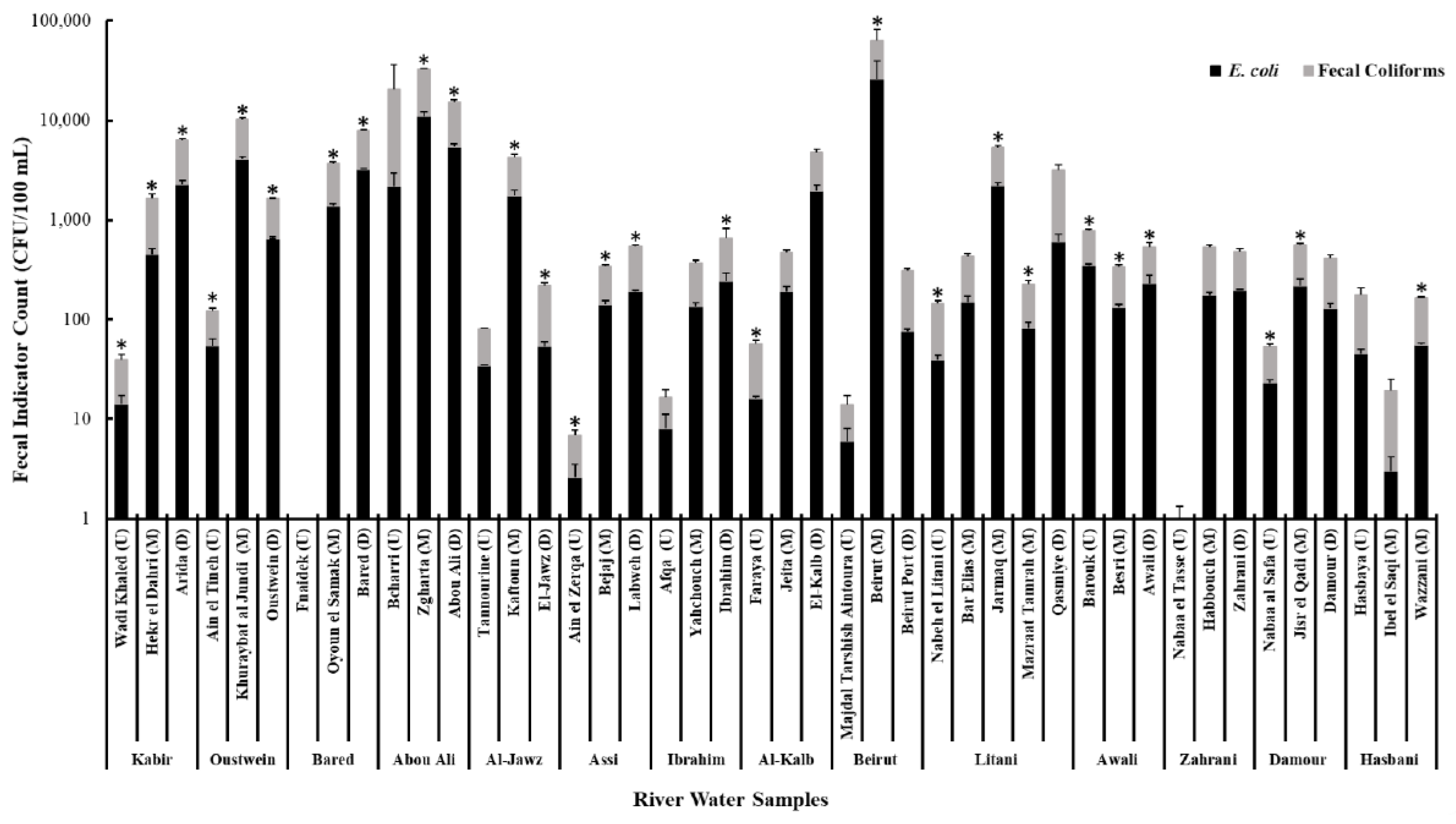

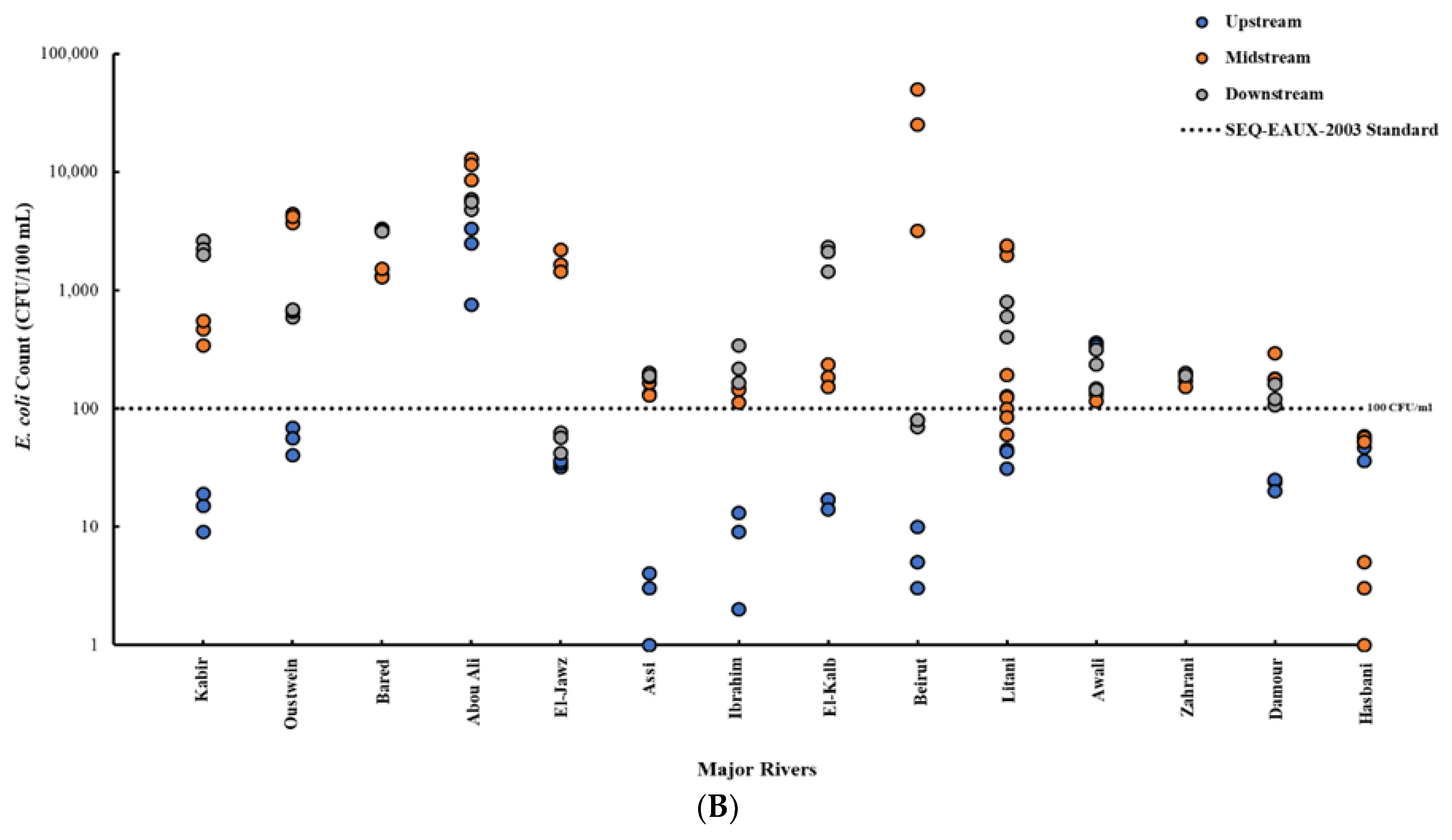

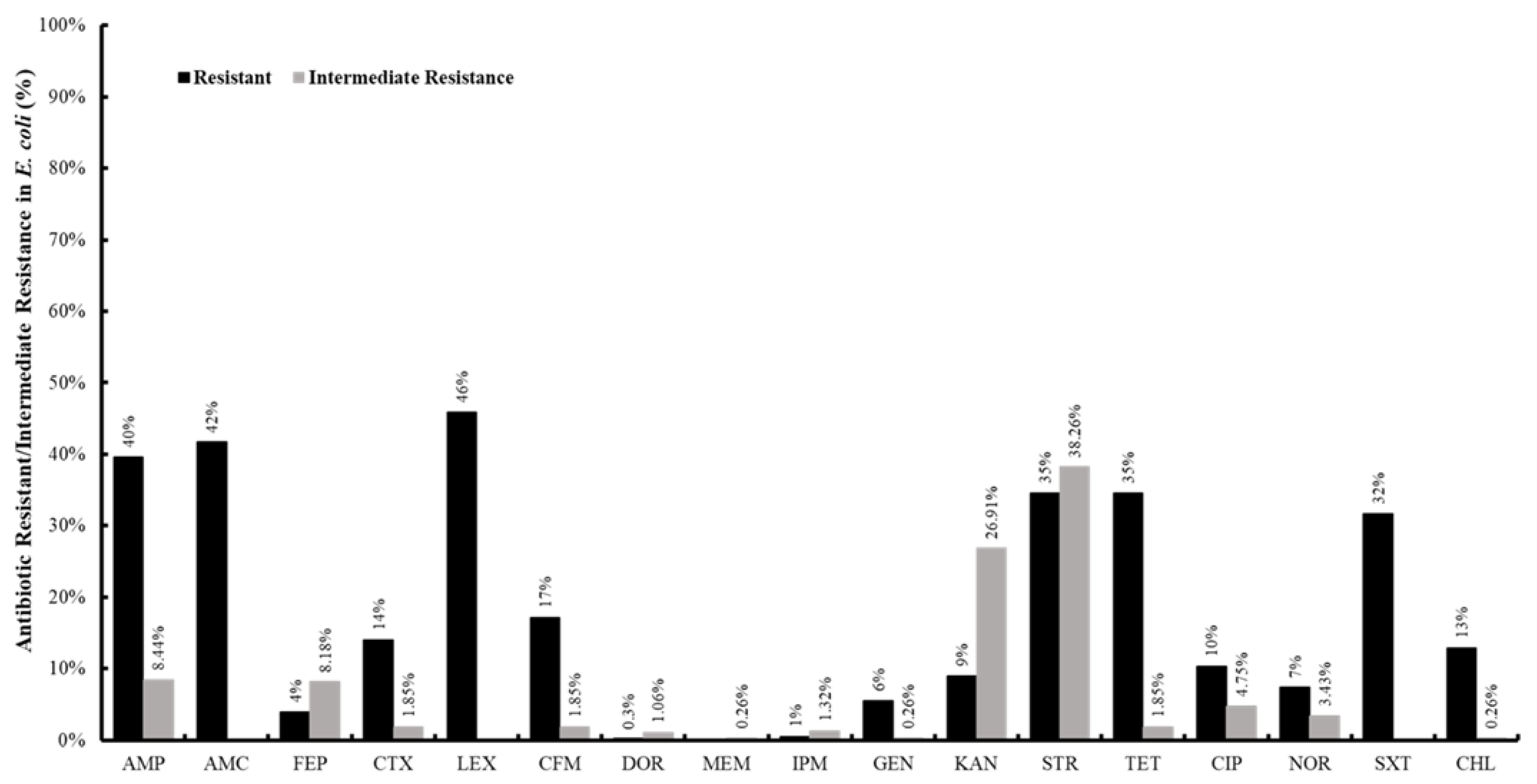
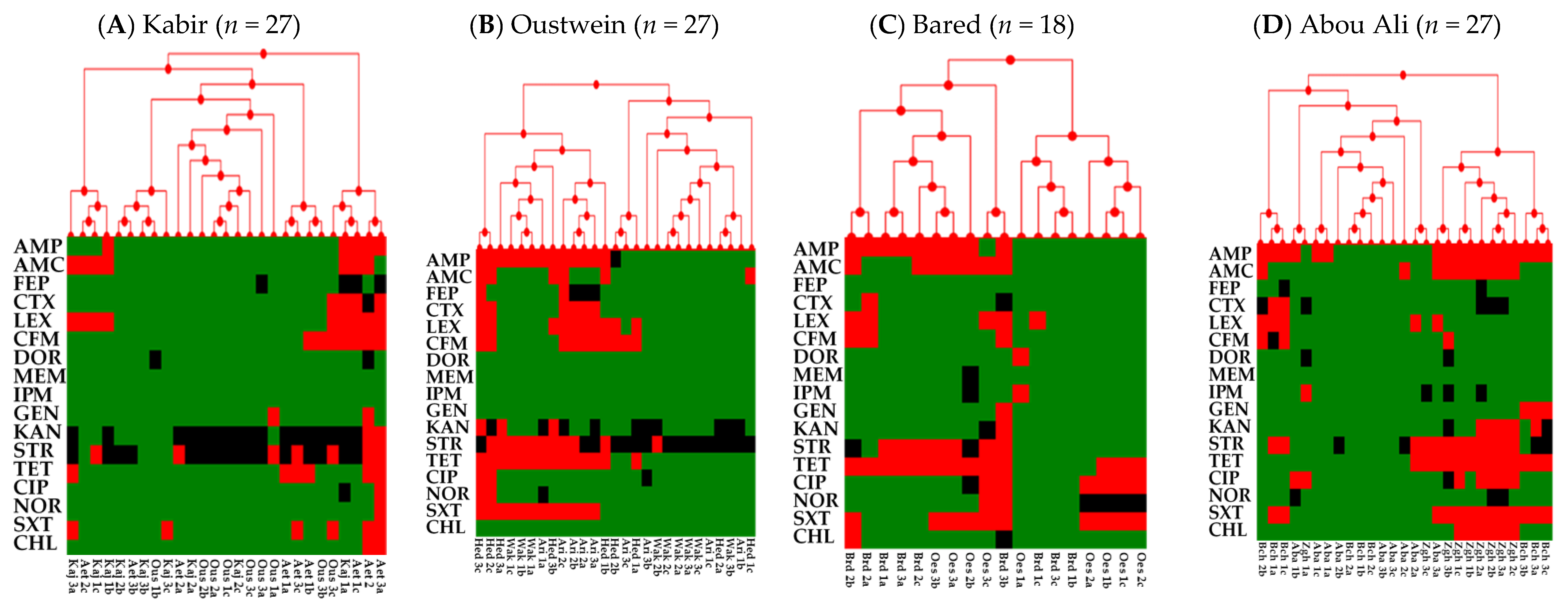
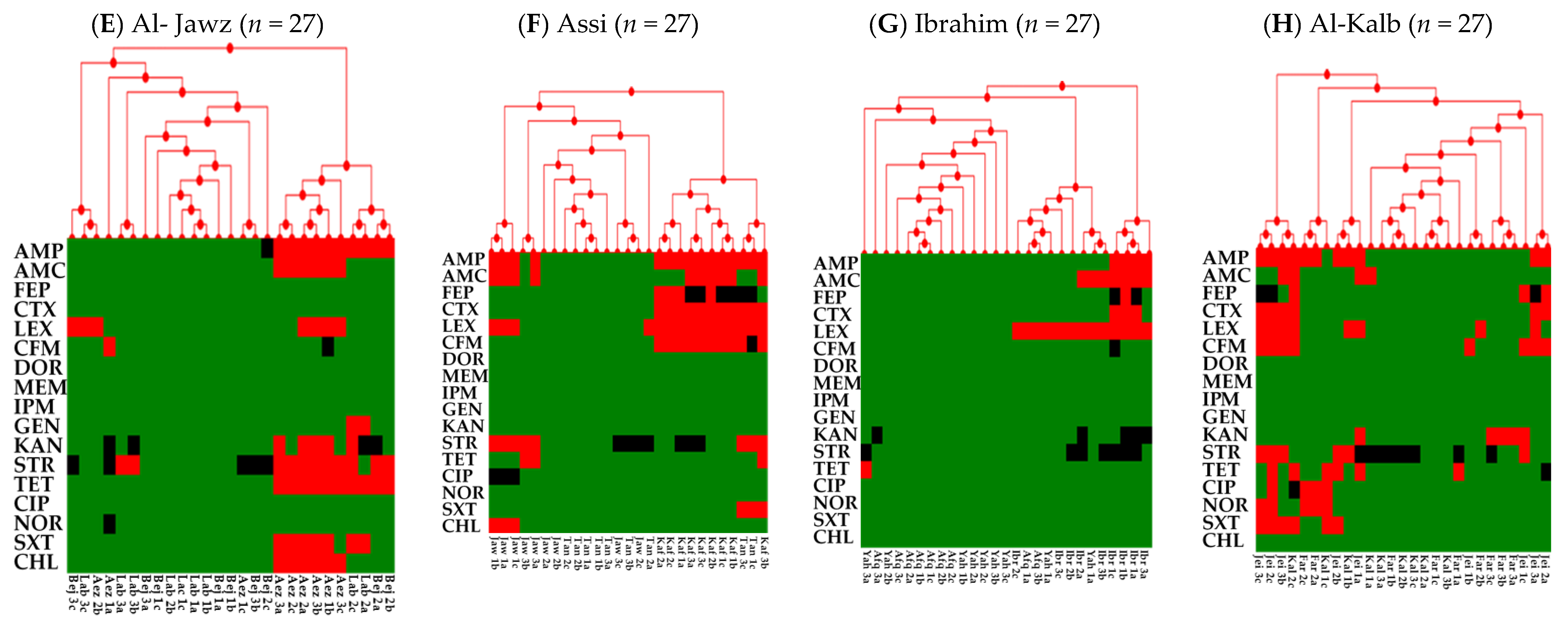
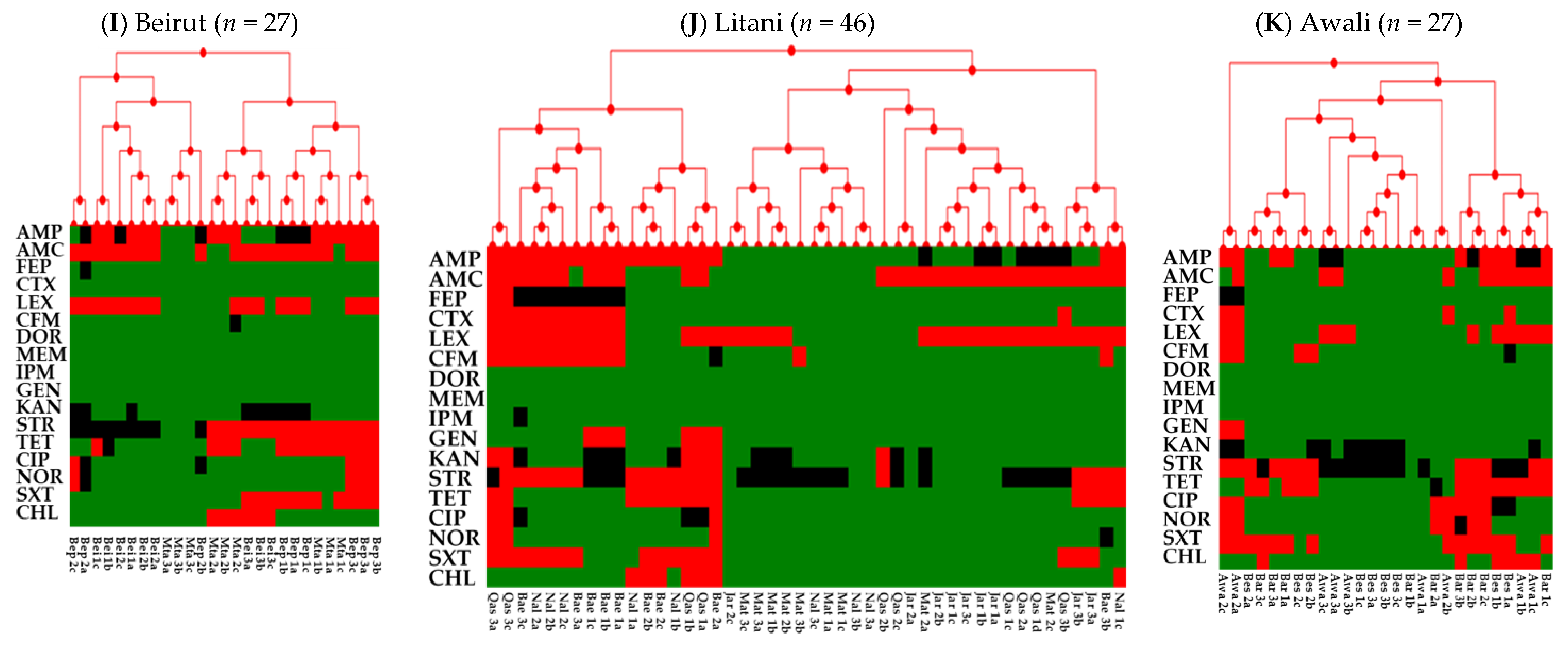
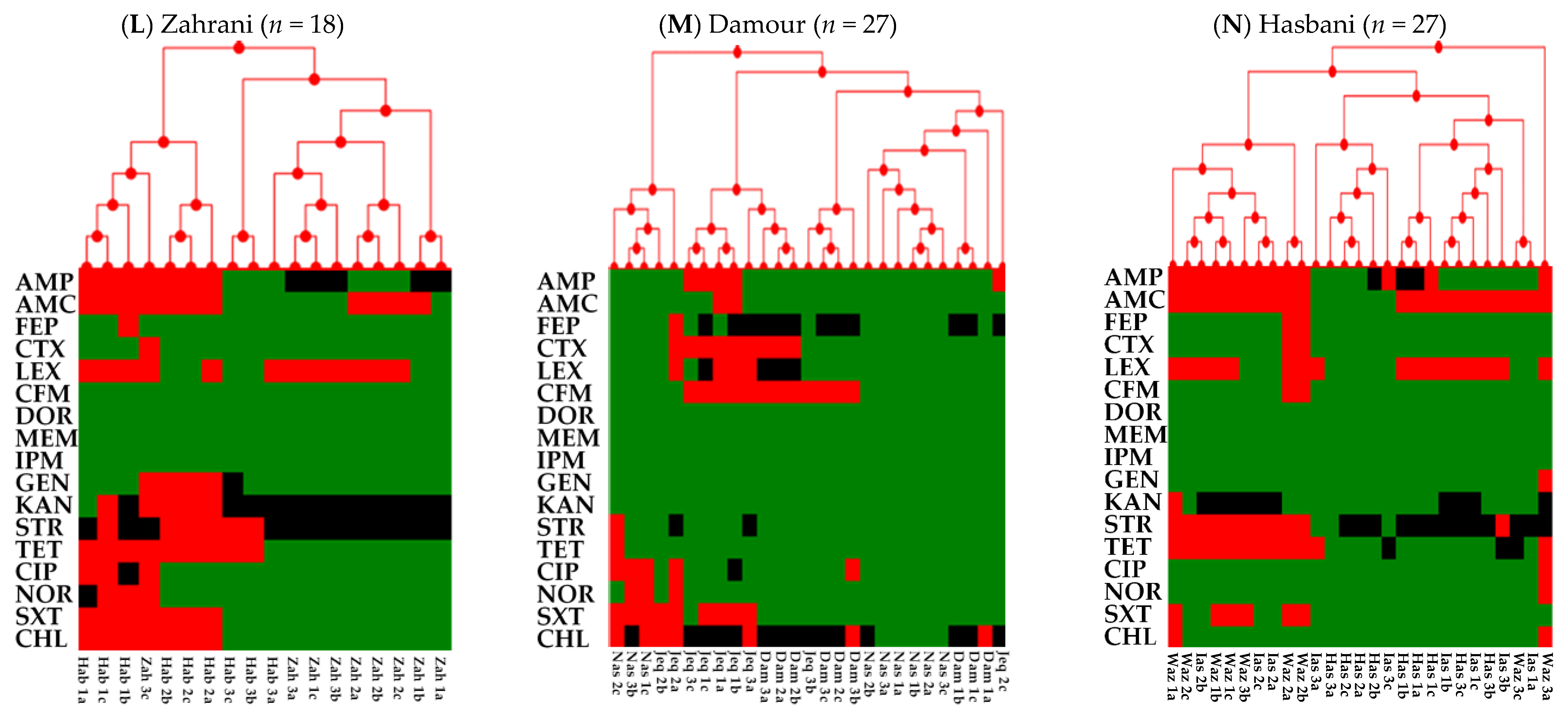
| Name of Major River | Sampling Site | ||||
|---|---|---|---|---|---|
| Upstream (ID) | Midstream (ID) | Downstream (ID) | |||
| Kabir | Wadi Khaled (Wak) | Hekr el Dahri (Hed) | Arida (Ari) | ||
| Oustwein | Ain el Tineh (Aet) | Khuraybat al Jundi (Kaj) | Oustwein (Ous) | ||
| Bared | Fnaidek (Fna) | Oyoun el Samak (Oes) | Bared (Brd) | ||
| Abou Ali | Bcharri (Bch) | Zgharta (Zgh) | Abou Ali (Aba) | ||
| El Jawz | Tannourine (Tan) | Kaftoun (Kaf) | El Jawz (Jaw) | ||
| Assi | Ain el Zerqa (Aez) | Bejaj (Bej) | Labweh (Lab) | ||
| Ibrahim | Afqa (Afq) | Yahchouch (Yah) | Ibrahim (Ibr) | ||
| El Kalb | Faraya (Far) | Jeita (Jei) | El Kalb (Kal) | ||
| Beirut | Majdal Tarshish Aintoura (MTA) | Beirut (Bei) | Beirut Port (Bep) | ||
| Litani | Nabeh el Litani (Nal) | Bar Elias (Bae) | Jarmaq (Jar) | Mazraat Tamrah (Mat) | Qasmiye (Qas) |
| Damour | Nabaa al Safaa (Nas) | Jisr el Qadi (Jeq) | Damour (Dam) | ||
| Awali | Barouk (Bar) | Besri (Bes) | Awali (Awa) | ||
| Zahrani | Nabaa el Tasse (Net) | Habbouch (Hab) | Zahrani (Zah) | ||
| Hasbani | Hasbaya (Has) | Ibel al Saqi (Ias) | Wazzini (Waz) | Inaccessible * | |
Publisher’s Note: MDPI stays neutral with regard to jurisdictional claims in published maps and institutional affiliations. |
© 2021 by the authors. Licensee MDPI, Basel, Switzerland. This article is an open access article distributed under the terms and conditions of the Creative Commons Attribution (CC BY) license (https://creativecommons.org/licenses/by/4.0/).
Share and Cite
Dagher, L.A.; Hassan, J.; Kharroubi, S.; Jaafar, H.; Kassem, I.I. Nationwide Assessment of Water Quality in Rivers across Lebanon by Quantifying Fecal Indicators Densities and Profiling Antibiotic Resistance of Escherichia coli. Antibiotics 2021, 10, 883. https://doi.org/10.3390/antibiotics10070883
Dagher LA, Hassan J, Kharroubi S, Jaafar H, Kassem II. Nationwide Assessment of Water Quality in Rivers across Lebanon by Quantifying Fecal Indicators Densities and Profiling Antibiotic Resistance of Escherichia coli. Antibiotics. 2021; 10(7):883. https://doi.org/10.3390/antibiotics10070883
Chicago/Turabian StyleDagher, Lea A., Jouman Hassan, Samer Kharroubi, Hadi Jaafar, and Issmat I. Kassem. 2021. "Nationwide Assessment of Water Quality in Rivers across Lebanon by Quantifying Fecal Indicators Densities and Profiling Antibiotic Resistance of Escherichia coli" Antibiotics 10, no. 7: 883. https://doi.org/10.3390/antibiotics10070883
APA StyleDagher, L. A., Hassan, J., Kharroubi, S., Jaafar, H., & Kassem, I. I. (2021). Nationwide Assessment of Water Quality in Rivers across Lebanon by Quantifying Fecal Indicators Densities and Profiling Antibiotic Resistance of Escherichia coli. Antibiotics, 10(7), 883. https://doi.org/10.3390/antibiotics10070883








